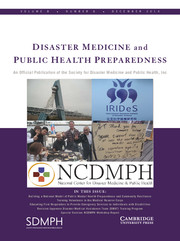On the Cover
Disaster Turns Into Blessings
-
- Published online by Cambridge University Press:
- 31 December 2014, pp. 463-464
-
- Article
- Export citation
Editorial
Fearbola
-
- Published online by Cambridge University Press:
- 31 December 2014, pp. 465-466
-
- Article
-
- You have access
- HTML
- Export citation
Letters to the Editor
A Need for Tetanus Vaccination Before Restoration Activities in Fukushima, Japan
-
- Published online by Cambridge University Press:
- 07 November 2014, pp. 467-468
-
- Article
-
- You have access
- HTML
- Export citation
Detecting Residual Fluorine 18 From a Medical PET-CT Procedure During Population Whole Body Counter Screening in Fukushima
-
- Published online by Cambridge University Press:
- 31 December 2014, pp. 469-470
-
- Article
-
- You have access
- HTML
- Export citation
Brief Reports
Impact of Natural Disaster Combined with Nuclear Power Plant Accidents on Local Medical Services: a Case Study of Minamisoma Municipal General Hospital after the Great East Japan Earthquake
-
- Published online by Cambridge University Press:
- 27 November 2014, pp. 471-476
-
- Article
- Export citation
Experience from the Great East Japan Earthquake Response as the Basis for Revising the Japanese Disaster Medical Assistance Team (DMAT) Training Program
-
- Published online by Cambridge University Press:
- 20 November 2014, pp. 477-484
-
- Article
- Export citation
Perceptions of the Utility and Acceptability of an Emergency Child Minding Service for Health Staff
-
- Published online by Cambridge University Press:
- 31 December 2014, pp. 485-488
-
- Article
- Export citation
Assessing Electronic Death Registration and American Red Cross Systems for Mortality Surveillance During Hurricane Sandy, October 29–November 10, 2012, New York City
-
- Published online by Cambridge University Press:
- 31 December 2014, pp. 489-491
-
- Article
- Export citation
Original Research
Effects of the July 1997 Floods in the Czech Republic on Cardiac Mortality
- Part of:
-
- Published online by Cambridge University Press:
- 24 November 2014, pp. 492-496
-
- Article
- Export citation
Behavioral Consequences of Disasters: A Five-Stage Model of Population Behavior
-
- Published online by Cambridge University Press:
- 20 November 2014, pp. 497-504
-
- Article
- Export citation
Methods of Instruction of the Incident Command System and Related Topics at US Veterinary Schools
-
- Published online by Cambridge University Press:
- 21 November 2014, pp. 505-510
-
- Article
- Export citation
Building a National Model of Public Mental Health Preparedness and Community Resilience: Validation of a Dual-Intervention, Systems-Based Approach
-
- Published online by Cambridge University Press:
- 08 December 2014, pp. 511-526
-
- Article
- Export citation
Developing Strong Response Capacity: Training Volunteers in the Medical Reserve Corps
-
- Published online by Cambridge University Press:
- 31 December 2014, pp. 527-532
-
- Article
- Export citation
Educating First Responders to Provide Emergency Services to Individuals with Disabilities
-
- Published online by Cambridge University Press:
- 31 December 2014, pp. 533-540
-
- Article
- Export citation
Comparison of Injury Epidemiology Between the Wenchuan and Lushan Earthquakes in Sichuan, China
-
- Published online by Cambridge University Press:
- 17 December 2014, pp. 541-547
-
- Article
- Export citation
Radiology Diagnostic Devices Under Emergency Electric Power at Disaster Base Hospitals During the Acute Phase of the Great East Japan Earthquake: Results of a Survey of All Disaster Base Hospitals in Miyagi Prefecture
-
- Published online by Cambridge University Press:
- 10 December 2014, pp. 548-552
-
- Article
- Export citation
NCDMPH Workshop Report Special Section
Special Section- NCDMPH Workshop Report
-
- Published online by Cambridge University Press:
- 31 December 2014, p. 553
-
- Article
- Export citation
Introduction and Overview to the Report of Workshop: Learning in Disaster Health 2014
-
- Published online by Cambridge University Press:
- 31 December 2014, p. 554
-
- Article
- Export citation
Introduction
-
- Published online by Cambridge University Press:
- 31 December 2014, p. 555
-
- Article
- Export citation
General Session: Welcome and Opening Remarks
-
- Published online by Cambridge University Press:
- 31 December 2014, pp. 556-557
-
- Article
- Export citation



